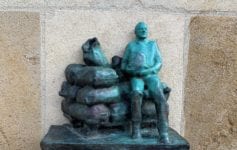
Those of us of a certain age will remember only too well the pervading threat of nuclear war during the 1960s and 70s and its gradual demise during the 1980s. The collapse of the Berlin Wall in 1989 signalled a new era and in 1991, when the Soviet Union was dissolved, the Cold War officially ended.
But in those intervening years, from the mid-fifties onwards, the UK government began to protect the country from a nuclear attack. Over 1500 nuclear monitoring posts were constructed at a distance of about 15 miles apart. The Royal Observer Corps, who had been used during World War II to identify enemy aircraft, had a new role in staffing these posts.
Only a small number of ROC bunkers have been preserved for posterity, one in my own town of Holbeach in Lincolnshire. A charity, Heritage Lincolnshire, has, over the years, managed to gather together the items that would have been kept in the bunker during the Cold War years. On a regular basis they open up the bunker for small groups of visitors to discover more about the vital work of the ROC during the years of nuclear monitoring.
A couple of weeks ago my son Rory and I donned hard hats in order to clamber down the vertical ladder into the Holbeach bunker. I didn’t even know where it was, which is a shameful admission. It was only a few minutes drive away (we could have walked!) in a field just north of the town. I couldn’t believe I’d not noticed it before, this large, dark green metal box, fenced off from the road.
After a safety briefing, our small group had the pleasure of meeting our guide, Charles Parker, who had amassed 29 years of service with the Royal Observer Corps. Charles spent 45 minutes enthralling us with the history of the ROC post and showing us how the equipment worked in the event of a nuclear attack. There were a number of tours that day and Charles kept going with his engaging talk for each eager group.
Three ROC personnel would have staffed the post in time of a significant nuclear threat. In the meantime, regular practices took place. Charles pointed out the features of the post visible above ground including the bunker hatch with the attached Ground Zero Indicator and the baffle plate of the Bomb Pressure Indicator.
Underground, once the vertical ladder had been tackled, the surprisingly roomy bunker came into view as our eyes adjusted to the dimmed light. We saw where the three men worked, slept and cooked. There was also a separate area which housed a chemical toilet.
We heard how the government broadcast warning system would give notice of a nuclear attack and the lucky Number 3 Observer would climb the ladder to start up the siren outside, before quickly returning. The bomb blast would be measured, with the figures radioed in to the triangulation team at HQ in Lincoln. These figures, along with those from the fall-out indicator, would be added to similar data from other posts, plus local weather forecasts, to determine where the bomb had exploded and where the fall-out was likely to land. Each member of the team wore a Personal Dose Rate Meter and their roles would have been rotated depending on the levels of radiation exposure.
Over time, technology improved so this forecasting could be done by satellites. The threat of a nuclear attack also subsided so all the posts were decommissioned in 1991.
When we climbed up to the surface again I had a chat with Frank and Jean Saunston. Frank was the Chief Observer for the ROC in Holbeach and now aged 92 and wearing his old ROC uniform, he was delighted to talk to visitors, giving them first-hand stories of his time in the bunker. He also told me tales of his time in the war. He had been part of three different commands, including RAF Bomber Command and Coastal Command. I was fascinated to hear of his involvement in Operation Manna towards the end of the war, when Lancasters from the RAF dropped food supplies instead of bombs onto German-occupied Holland. Over 3000 sorties were made, dropping tinned food, dried food and chocolate to help feed Dutch civilians at risk of starvation. It was a real pleasure to talk to Frank and appreciate how much he did in both the war years and the post-war years, manning the ROC post.
Rory and I both felt very privileged to have visited the bunker, especially as I had only learned about the free tours a couple of days beforehand. Heritage Lincolnshire is a charity which maintains this site, as well as a number of other buildings in the county, ensuring our local history is preserved. Local volunteers keep the ROC post in good order. It’s thanks to them we have this extraordinary piece of history on our doorstep.




Really interesting stuff. I remember trying to go to sleep under my duvet when I was young, as I thought that would protect me if a bomb fell during the night. The threat was very real. I’d heard about bunkers like these, but didn’t know you could have a guided tour. I wonder what went through the minds of the three people as they stayed there for the drill?
It’s awful to now be worrying about the possibility of nuclear war again. It was a real threat when we were younger, wasn’t it. I think the servicemen who worked shifts to cover the practice nights probably accepted it as a job they had to do, as they did in the war. The chap I spoke to used to cycle down to the bunker and they would cook meals there too.
Great to revisit this post as part of #CulturedKids. Thanks for linking up!
Great to see what everyone else has been doing – always inspiring.
Amazing! I can see that you wouldn’t notice the bunker before, but I bet you eyes will be drawn to every time you drive past now. How brilliant to be able to talk to someone who worked there too it makes everything seem so much more real. Thank you for linking up to #CulturedKids
I’ll be on the look out for them whenever I drive around the UK – green metal boxes will catch my eye. It really was a fascinating day and yes, meeting Frank was so interesting. I think he enjoyed having a purpose after the war, volunteering for this job every week. He had a no-nonsense approach to it all.
How funny that this place is just up the road from you and you’d never noticed it. It just goes to show that there are always places to explore on our doorstep.
I haven’t visited a bunker like this but have visited a similar in Tynemouth near us – it’s amazing to see isn’t it.
Let’s hope we won’t need to use them any time soon though :-O
It’s a small country road I don’t usually go along but even so, I didn’t know of its existence at all. And I’ve lived here for over 20 years!
Will have to find out more about the Tynemouth one for when I’m next back up north.
Let’s hope this remains in history. #culturedkids
Indeed. It felt very timely to be visiting the bunker at a time when the world is anxious once again about a nuclear threat. These bunkers will remain in history as they were purely monitoring posts and would not be used for that purpose again.
I definitely remember feeling the latent threat of nuclear war growing up in the 70’s and 80’s. I cried watching the images of the Berlin wall come down in 1989. Feels surreal that nuclear missile threat is a potential again. I would prefer these bunkers remain a fixture in history. #CulturedKids
These bunkers were monitoring posts so would never be used again for that, as technology has moved on, and they are too small to be public shelters – so they will, thankfully, remain in history. But it is awful to imagine having to consider constructing underground shelters once again.
What an unexpected site to uncover on your doorstep. Sounds interesting. I’ve been aboard a nuclear submarine but never inside a bunker. #culturedkids
I’ve never been inside a nuclear submarine! I’ll have to do that and you’ll have to find a bunker!
This sounds brilliant – what an interesting place to go. Can’t believe it was so near you! Would love to visit myself. Wonderful to have such dedicated volunteers keeping places like this going.
It’s worth having a search online to find where the nearest one is to where you live, although very few have been restored for visitors. But interesting to know where they are.
Oh how interesting to go on a tour – and I love it when a guide makes the history come alive. And yes, it seems like a particularly timely post – with days of cold war threat feeling not so far away again… #culturedkids
Our guide was so interesting – he did a number of tours that day, hardly had time for his lunch in between times!
I remember being quite scared of nuclear war during the 80s and asking where the nearest bunker was. I’m not surprised you didn’t notice it though Trish as it has quite a subtle entrance. Interesting that it was only designed to house 3 people – hopefully I am reading that right. It’s frightening to think what would have happened to everyone else.. #culturedkids
These nuclear bunkers were purely monitoring posts, Katy, designed for three service personnel. I don’t think there were many bunkers designed for the general public – we wouldn’t have stood a chance!